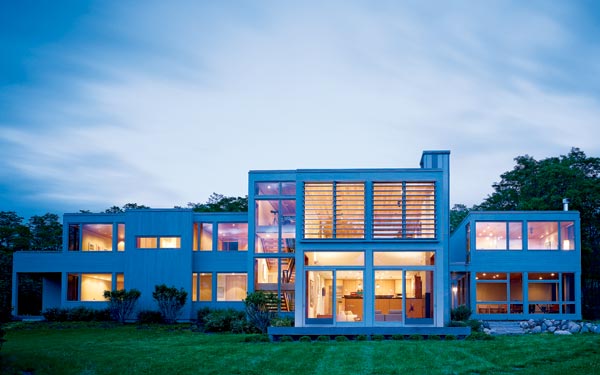 |
|
Making waves: The view of the house from the lakeside highlights its three pavilions—sleeping quarters on the left, public areas in the center, and the guesthouse on the right. Photo Gallery::: |
The site for this modernist lakefront house in northern Michigan’s Leelanau County is densely wooded, with views of Sleeping Bear Dunes, distant freighters gliding along a major aquatic highway, and painterly sunsets that linger. With the two-story gray cedar house completed, its conception and invention seem like part of the natural order of things. But it came to be only through a series of loopy yet genuine links—the kind of cosmic coincidences that drive the plots of Thomas Hardy novels. »
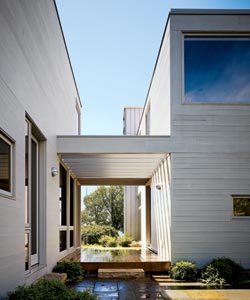 |
|
An outdoor passageway connects the main house with the guest quarters. |
Among the main characters in this story: the owners, who prefer not to be named. This is the second marriage for both—she a former management consultant and a journalist (known in some circles for eliminating the name-dropping social coverage from a newspaper she once edited), and he an executive in residence at the University of Michigan’s Stephen M. Ross School of Business and a venture capitalist in the health-care field. Also appearing: the wife’s mother (she may be small, but she’s mighty). James Nagle, a principal in the Chicago firm Nagle Hartray Danker Kagan McKay Penney Architects Ltd. The Michigan developer and contractor James A. Bagaloff. The interior designers Andrew Fisher and Rita Whaley. "We had an incredible collaboration between the architect, the builder, and the designers," the wife says, "and I give us a little credit, too."
This SAGA began in 2000 when the husband went to join his wife in Florence, Italy. A longtime devotee of architecture and design magazines, she suggested one day that he take a look at an issue of Ville Giardini. Expecting Renaissance excess, he flipped through and found a story about a modern house in Door County, Wisconsin, designed by Nagle. About that time, Nagle was in Rome, and he saw the same story, placed by his firm, when he picked up the magazine at a newsstand.
When the couple from Michigan returned to their primary residence in Ann Arbor, the husband called Nagle in Chicago to ask about the possibility of his building a house for them near Sleeping Bear Dunes. Nagle said that he knew the area well. The Chicago architects Cindy and Ben Weese, friends of his, had a second home there, as did the landscape architect Joe Karr, another colleague.
And then the connections looped again. In the late fifties and early sixties, when the husband attended the University of Iowa Laboratory School in Iowa City, he had worked for Nagle Lumber, a company run by Nagle’s father and older brother—just one of a string of family ties that client and architect discovered. They hadn’t known each other when they were younger, the client says, because Jim was the academic star of the family and was usually away at school.
"I thought it would be crazy to look any further," the husband says. "This was like a friend of the family, and he had designed a great house in Wisconsin."
"I thought that was a small-world thing," Nagle recalls. "So we got together and have become friends."
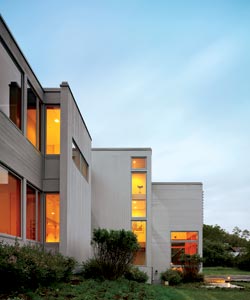 |
|
Playing it cool: To articulate different sections of the exterior, the gray solidstained cedar siding was placed horizontally and vertically. |
And the march to nirvana began. A previous glitch had been resolved to the clients’ advantage. They had started out with property a mile inland from their eventual site. "It was on a Jeffersonian knoll that I thought would be incredible," the husband explains. But when he and his wife returned from a trip, they found that between their land and the lake, someone had built a giant sheet-metal barn with a bright-blue roof.
Heartbroken but resilient, the couple resumed their search and found a for-sale sign on a lakefront lot in a century-old estate that had originally belonged to a lumber baron. "Finally, we took Mom on a walk and showed her the lot," the wife recalls, "and she said, ‘You know, the sunsets from here would be really nice.’ And the next day, we decided to buy the lot from Jim Bagaloff."
Mom lives in a cottage on a nearby lake, but she is blunt about the villainy of the early lumber-company owners: "They abso- lutely raped the land." She also acknowledges an upside: "They became uneasy and felt they had to contribute, so you’ll find a library, a hospital, an art gallery all the way down the coast courtesy of the lumber barons." And the trees came back with a majestic vengeance.
Next: Kitchen and Living Room
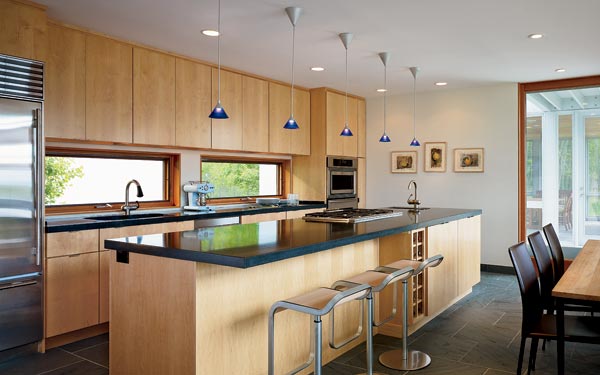 |
|
|
All the right angles: In the kitchen, light maple cabinetry contrasts with dark concrete countertops—a juxtaposition that reappears in the wood and steel of the staircase. |
That was clear to Jim Bagaloff, then the owner of a financial-services company in Lansing, when he went to take a look at the estate in 1978. He was reading The Wall Street Journal one Friday afternoon when he spotted an ad for the property—half a mile of frontage on Lake Michigan, three homes, two barns, a quarter of a mile of an inland lake. He looked at the property on Saturday, and his offer was accepted on Tuesday. His plan was to live in the community and develop the site.
"If I hadn’t picked up that newspaper," Bagaloff says, "I would have never known about it."
"And he had the will to act," the husband says, "which most people lack."
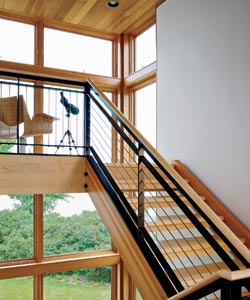 |
|
At the top, a Buttercup chair by Blue Dot and a telescope offer a long view. |
But the husband obviously isn’t one of those people. At the beginning of the project, he gave Nagle four pages of planning guidelines for the house. Among the specifics: overall design concepts, desired views, public-area layouts, accommodations for guests, placement of decks, storage needs. Proving that some great visionaries think alike, Nagle was right back at the clients with a preliminary sketch.
Over time, they made changes—windows and decks were added; a room went upstairs and a screened-in porch came down; materials were carefully chosen to avoid exacerbating the wife’s allergies. Bagaloff, who lived nearby, took on the contracting responsibilities; the California designer Andrew Fisher, who had worked on the clients’ condominium in San Francisco, flew in for an initial visit; Rita Whaley, who had previously collaborated with Bagaloff, was brought in to handle on-site design concerns and to be a go-between for the architect, the contractor, and the often-absentee owners.
Building began at the bottom of the property, the husband explains, with a deck on a bluff and a stairway descending to the beach. The guesthouse was finished first; with that structure in place, the clients could stay there on visits while the main house was under construction. That or camp out beneath northern Michigan’s brilliant stars.
When I visit in late summer to see the grand plan fully realized, I initially go in a side entrance and then insist that for a true sense of arrival, we will have to begin again. Repairing to a point just beyond the main entrance of the property, the husband and I walk straight ahead and encounter a large stand of birch trees encircled by flowering shrubs; pine trees line either side—an arrangement designed by Joe Karr, a Chicago landscape architect, to enhance and conceal.
"I wanted privacy and then the mystery of the house," the husband explains. We continue down a covered walkway that allows a view through the house and on to today’s calm lake—a sense of transparency prevails throughout the property. And no doorbell here; guests announce their presence by walloping a Burmese temple gong.
Inside, the mood is easy, the weight of worldly gravity relieved. As requested in the planning guidelines, the living and dining areas and the kitchen are open to one another. The woods are light but varied—maple for the cabinets in the kitchen and the living room (with storage to the max built in), cedar for the ceilings, slate floors that give way to cherry.
The furnishings in the house are a blend of the comfortable and the custom made (Fisher-designed sofas and chairs), midcentury modern classics (tables by Warren Platner), and antiques (a tall butternut cabinet and Pennsylvania Dutch beds that belonged to the husband’s father).
The owners prefer to mix the antique and the modern. "Often people think that in homes this contemporary, you need to stay with that," Whaley says. "But this house has personality. Don’t you see it? It’s warm." The goal here: clean lines, simple lines, comfort.
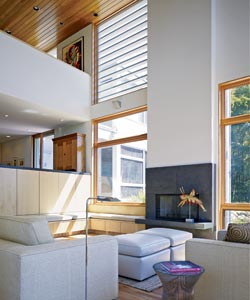 |
|
In the two-story living room, custom-made furniture was combined with sixties-designed end tables by Warren Platner. Beside the concrete fireplace is a surrealist assemblage by Gerome Kamrowski. |
A hallway to the right of the entry leads to a TV room, painted a punchy persimmon to contrast with an otherwise off-white palette. Outside the guest room at that end of the house hang historical photos of the logging days and the surrounding topography. Together, the owners have four children and two grandchildren, and just about every room in the house is equipped to accommodate one or more guests (no crowding!).
Upstairs, the hallway on the right leads to a sitting room (the snoratorium, the husband calls it) and the master bedroom and baths. The wife’s custom-built closet, with its special scarf-hanging compartments, is a wonder all its own. Studies for the couple are situated at the opposite end of the floor, overlooking the living room. Cabinets that didn’t quite work downstairs were refitted to go here and will eventually hold the husband’s antique toy collection.
When Whaley visited the clients at their home in Ann Arbor (a sixties design by the architect George Brigham) while this project was in progress, she noted differences in style but consistencies in the appreciation of art and nature. It was important to the couple, in their new house, to avoid barriers between inside and out but also to design enough spaces to keep artwork safe from the sun. Collages by Alan Shields appear on every level of the central stairway. Works by Jim Dine and Anni Albers hang elsewhere. Beside the living-room fireplace stands a surrealist assemblage by Gerome Kamrowski.
Places for additional artwork are here and there, a necessity for all collectors. But the owners are pleased with things as they are. By the time they were done, the wife says, they had left no design possibility unexplored. There is certainty for her in where that effort led: "We ended up with the perfect house."
Next: Resources
Photography: Scott McDonald/ Hedrich Blessing
RESOURCES
James A. Bagaloff, Brad Bagaloff, 10377 Niagara Street, P.O. Box 477, Empire, Michigan; 231-326-5959. The general contractors.
Bay House Design (Tyler Oosterhouse), 3052 Keystone Road, Traverse City, Michigan; 231-883-8581. The concrete countertop and decorative concrete contractor.
Fisher Weisman (Andrew Fisher), 616 Minna Street, San Francisco, California; 415-255-2254. Interior design.
Interior Design Studio (Rita Whaley), 1439 Barlow Street, Traverse City, Michigan; 231-935-1888. Interior design.
Joe Karr Landscape Architect, 619 West Ful- lerton Parkway; 773-528-6747. The landscaping.
Nagle Hartray Danker Kagan McKay Penney Architects Ltd. (James Nagle, Dirk Danker, principals; Tim Sheridan, project architect; Rocco Castellano, architect), 30 West Monroe Street, Suite 700; 312-425-1000. The architects.
Quartersawn Custom Carpentry (Matthew Belch), 1323 Michigan Avenue, P.O. Box 81, Benzonia, Michigan; 231-882-4787. Carpentry.
Three Chairs Company, 215 South Ashley Street, Ann Arbor, Michigan, 734-665-2796; 215 South River Street, Holland, Michigan, 616-393-9433; 14299 Clay Terrace, Carmel, Indiana, 317-815-1330. The molded plywood Buttercup chairs by Blue Dot.


